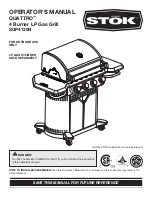
16
Figure 10
The hose and regulator are connected in the following
manner:
Slide back the collar of the quick disconnect on the tank
valve. Figure 10 (a). Push the male fitting of the regulator
into the quick disconnect, and maintain
pressure. Slide the collar closed. Figure 10 (b) shows the
quick disconnect engaged. Figure 10 (a) shows various
components of the tank and regulator.
(b)
Valve handwheel
Tank valve
Pressure
relief valve
Test valve
Regulator
Hose
(a)
Figure 11
Step 11
Check for gas leaks
(a)
(b)
Test valve in
CLOSED
position
Test valve in
OPEN
position
DANGER
Do not use an open flame to check for gas
leaks. Be sure there are no sparks or open
flames in the area while you check for leaks.
This will result in a fire or explosion which
can cause serious bodily injury or death
and damage to property.
WARNING: Check for gas leaks every time any gas
fitting is disconnected and reconnected.
You will need: a soap and water solution and a rag or
brush to apply it.
Note - Since some leak test solutions, including soap
and water, may be slightly corrosive, all connections
should be rinsed with water after checking for leaks.
To perform leak checks: Turn test valve to the CLOSED
position. Figure 11. Turn tank valve ON
(counterclockwise). Check for leaks by wetting the
connections with the soap and water solution and
watching for bubbles.
Check the following connections, as shown in figure 11:
a) Test valve to regulator connection.
b) Quick disconnect fitting to LP tank connection.













































